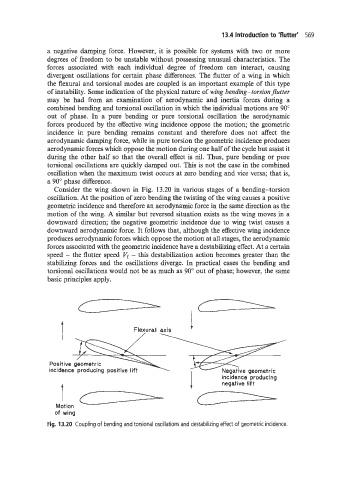Page 588 - Aircraft Stuctures for Engineering Student
P. 588
13.4 Introduction to 'flutter' 569
a negative damping force. However, it is possible for systems with two or more
degrees of freedom to be unstable without possessing unusual characteristics. The
forces associated with each individual degree of freedom can interact, causing
divergent oscillations for certain phase differences. The flutter of a wing in which
the flexural and torsional modes are coupled is an important example of this type
of instability. Some indication of the physical nature of wing bending-torsion flutter
may be had from an examination of aerodynamic and inertia forces during a
combined bending and torsional oscillation in which the individual motions are 90'
out of phase. In a pure bending or pure torsional oscillation the aerodynamic
forces produced by the effective wing incidence oppose the motion; the geometric
incidence in pure bending remains constant and therefore does not affect the
aerodynamic damping force, while in pure torsion the geometric incidence produces
aerodynamic forces which oppose the motion during one half of the cycle but assist it
during the other half so that the overall effect is nil. Thus, pure bending or pure
torsional oscillations are quickly damped out. This is not the case in the combined
oscillation when the maximum twist occurs at zero bending and vice versa; that is,
a 90" phase difference.
Consider the wing shown in Fig. 13.20 in various stages of a bending-torsion
osciiiation. At the position of zero bending the twisting of the wing causes a positive
geometric incidence and therefore an aerodynamic force in the same direction as the
motion of the wing. A similar but reversed situation exists as the wing moves in a
downward direction; the negative geometric incidence due to wing twist causes a
downward aerodynamic force. It follows that, although the effective wing incidence
produces aerodynamic forces which oppose the motion at all stages, the aerodynamic
forces associated with the geometric incidence have a destabilizing effect. At a certain
speed - the flutter speed V, - this destabilization action becomes greater than the
stabilizing forces and the oscillations diverge. In practical cases the bending and
torsional oscillations would not be as much as 90" out of phase; however, the same
basic principles apply.
t Flexural axis
'
Positive geometric
incidence producing positive lift Negative
%% geometric
incidence producing
negative lift
Motion 1-
of wing
Fig. 13.20 Coupling of bending and torsional oscillations and destabilizing effect of geometric incidence.

